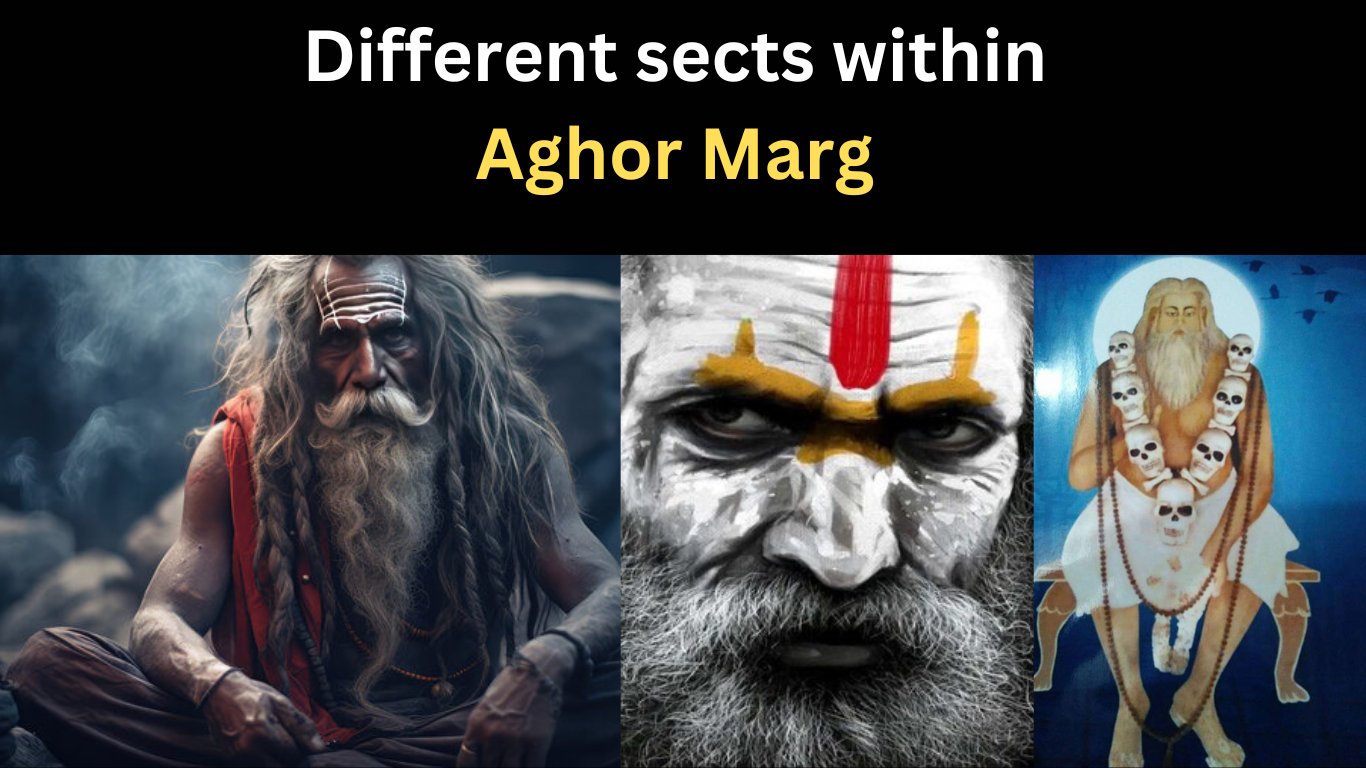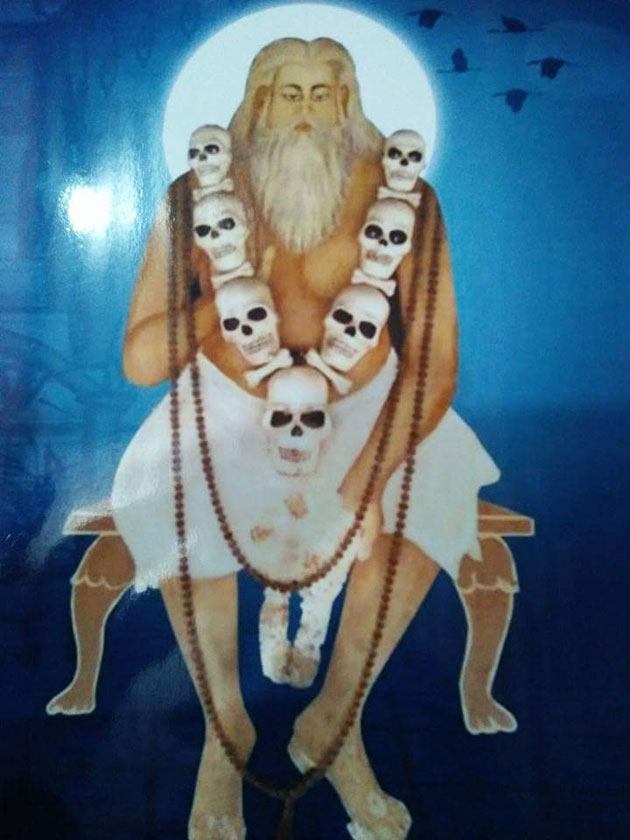Different sects within Aghor Marg

In this blog, I’ll tell about the origin story of the major branches of Aghor Marg.
Before we delve into the subject of how the various systems of Aghor came into being. It’s important to know about two major incidents, which are:
- The beheading of Brahma
- The incident of Samhara Muhurthams of Shiv
The beheading of Brahma
First going to the incident of Brahma Sirocchedan or the episode of beheading of Brahma. Three major incidents gave rise to two major branches within the sects that became classified under Aghor.
Concerning the incident of Ling-Udbhav (Shivlinga origination) when Brahma and Vishnu competed against each other for supremacy, Shiv manifested itself as the infinite column of fire. When Brahma raced upwards and couldn’t find its end, he became agitated, and then when he saw a Ketaki flower falling from above, he extorted the flower to become his witness. Shiv, who knew everything, became angry when Brahma dared to lie. From his nail came out Sri Kaalbhairav, who beheaded the fifth head of Brahma, which was the cause of his ahamkara.\
In another incident, when Shiv came as a crying baby to Brahma, and Brahma for no reason called him Kapali. To keep his word, Shiv feigned anger and became Kaalbhairav, who beheaded Brahma.
In another Kalpa, the Katha of Brahma Sirocchedan or beheading of Brahma states that the fifth head of Brahma used to give the knowledge of the Kama Veda, which has information only about Panchamakaras and Kaula marga, but the knowledge started to corrupt people and even Brahma, who made one mistake after another, which led Shiv to get angry, and Krodhbhairav manifested from his third eye, who in turn took off the fifth head of Brahma. Then he assumed the form of Kaalbhairav, who took up the dosh of Brahmhatya, and Kapala Bhairav, who took the kapala of Brahma (this is also accepted in Damara tantras).
The incident of Samhara Muhurthams of Shiv
Concerning the Samhara Muhurthams, they were taken by Shiv to slay the various avatars of Vishnu, such as Matsya, Kurma, Varaha, Nrisimha, and Vamana. According to Nath texts, Shiv took the form of the 28 Kapalins to slay the 24 main avatars of Vishnu who were causing trouble after getting drunk; the evidence for this is also found indirectly in the Sharabha Upanishad.
Different sects within Aghor Marg
Now the question arises as to why this is necessary information in the discourse, but that is the very answer to the question. The sects of Aghor all originated due to these various incidents.
The main sects within Aghor Marg are
- Vednidhi parampara
- Aghor Kapali
- Kalamukha Aghoris (now semi-extinct)
- Nath Parampara
- Kinaram Parampara
Vednidhi Aghor Parampara:
Vednidhi Parampara started from Kaalbhairav. After Brahma Sirocchedan or the beheading of Brahma Kaalbhairav took up the lent known as Nagnakapalika, where a set of rules had to be followed. During this period, he went to many places and reached Vaikunth, where Vishnu instructed him on the rules of Aghor.
From there, with newfound wisdom, he went to Kashi and sat under a tree where Brahmhatya came to him as a lady, and with her, he went to a river where he took a bath and got rid of the dosh of Brahmhatya. That place became known as Kapalamochan Ghat (which still exists in Kashi and is located in the Guhya Aghor). After being rid of the dosh of Brahmhatya, he became happy and, with his own amsha, he manifested a Manasputra whom he named Vednidhi and gave him the titles of Bhairav, Yati, and later Acharya. Sri obtained the Upadhi of Daak as well; that is why these are the three main titles of honor in the Vednidhi sect.
Kalamukha Aghoris
Next in line comes Kalamukha Aghoris, who came out of Kapali Bhairava along with the kapalikas of the shakta lineage. When Kapala Bhairav also went to Kashi and got rid of the kapala of Brahma attached to his nail, he started the panth of the shakta kapalikas along with his shakti kapalini. From this came the Kaalarudra sect, and from them came Kalamukhas. These Kalamukhas honed their sadhana pranali, and they became the Kalamukha Aghoris.
The Kapalika branch of Aghor is related to Vishnu Samhara; when Shiv took the form of 28 Kapalins and killed the main avatars of Vishnu only to revive his dearest bhakta later, these 28 Kapalins came to earth and established the Shaiva Kapalika lineage and are connected to the sect of Nath and Lakula Pashupatas. Later, Sri Lakulisha revived the path established by the 28 Kapalins, and from this branch of the Shaiva Kapalikas came the Aghor Kapali sect.
Nath Aghor Marg
The next in line is the Aghor branch of the Nath sect, which itself has two major lineages that trace their origins to two different main gurus.
First are the Goraksh Panthis, who come from guru Gorakshnath ji Maharaj. The origin of this panth goes as follows: When Shiv (Kapali aka Adinath) was giving mantra-upadesh (Mantra preaching) to Parvati (Kapalini) on a riverbank, a fish heard the discourse and, by the power of mantras, became a human who approached Shiv. Shiv was pleased with the results of his mantra and named him Matsyendranatha and asked him to ask for a vardan. Guru Matsyendranath demanded that Shiv should become his disciple (Sishya), and Shiv agreed. From this originated Goraksh Panth.
Boon to Maa Parvati
Seeing this, Kapalini asked for the same boon, but Shiv said that as he had already given the boon to Guru Matsyendranatha, he couldn’t do the same for her. But in turn, he gave her an alternative. He stated that Parvati will be born in male form and Ganesh will also be born as a human and become her disciple, while Shiva will become the disciple of Guru Matsyendranath. All the disciples from the lineage of Parvati and Ganesh will be hailed as walking Shivas. This lineage became known as Paav Panth, who mainly specialized in Aghor Sadhanas.
The lineage of Guru Matsyendranath and Guru Gorakshnath were heavily connected to the Shaiva Kapalikas and incorporated their sadhanas into the sect along with Shabarachar.
The lineage of Paav Panth was inherently based purely on shabarachar, but the sadhana method included a predominance of the use of Panchamakaras and Shamshan sadhanas. This branch is also connected to the Shaiva Kapalikas but also with the Shakta Kapalikas.
Both these sects specialized in Aghor Sadhanas. While the people of Guru Matsyendranath and Guru Gorakshnath can become Aghori by attaining Aghor Avstha, the people from the lineage of Paav Panth are generally called Nath Aghori.
Kinaram Aghor Marg Parampara
The last in the line is Kinaram Aghor Parampara, which was named after Baba Kinaram, who revived the sect of guru Dattatray. Guru Dattatray was initially from the Shakta branch of Kapalikas but also practiced the sadhanas of Aghor and had his own lineage. This lineage heavily focused on Kaula Sri Vidya Upasana and also in sadhanas of Shamshan, Shabar mantra, and Damar mantras, along with minimal use of Vedmamtras as well.
The lineage of Sri Vidya remained different, and the lineage of the non-Sri Vidya tantra of Guru Datt also existed in our mortal realm; however, it slowly went dormant. Later, Baba Kinaram, who is amsha of Shiv himself, was born on earth to revive this sect. After birth, there were many divine incidents related to Baba Kinaram, after which he met guru Datt, who gave him diksha and siksha of Aghor Marg and urged him to establish Kinaram Aghor Parampara.

Here ends the topic Different sects within Aghor Marg. If you have any queries let us know in the comment box.